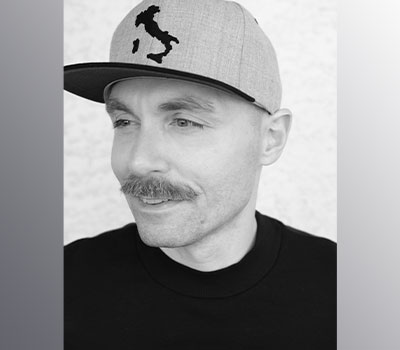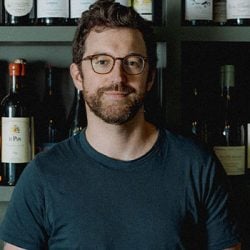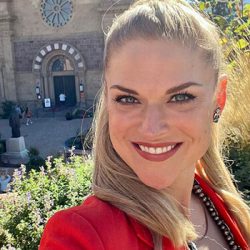Henry Davar had a meteoric rise to prominence as a sommelier. He entered restaurants as a second career, taking a glass-polishing position at the late, great ’inoteca on the lower east side of Manhattan. “It was my favorite restaurant in New York,” he recalls. It was convivial. It was easy. The food was great. Great atmosphere, great music. Really approachable—you could go there with your restaurant friends and enjoy a glass of wine. A good glass of wine.” He then moved to The Modern working for legendary restaurateur Danny Meyer. His dream was to work with the Bastianich Group at Babbo, and he managed an interview there, but the position had been filled. The sommelier at that time was David Lynch and he directed Henry to interview at the soon-to-open Del Posto, which he did, and where he accepted a job on the opening sommelier team of that groundbreaking fine dining palace. This led to a long relationship with that group, including a move to Las Vegas to open and run the programs at their collection of outlets there. Davar has now relocated to Los Angeles to run the programs at the Mozza Group, including Pizzeria Mozza, Osteria Mozza and Chi Spacca, and extensions of those concepts around the globe.—David Rosoff


At Mozza, you’re doing an all-Italian list, with the exception of Champagne. What categories of regions interest you the most?
At the restaurant, Italian whites is where a lot of the interest lies. I think the marketplace is so ill-equipped to speak about and to understand the inherent aromas and flavors and textures of Italian whites.
Certain categories are easier than others because there are surrogates, so to speak: We can take a Chablis lover to Etna or Verdicchio. And those happen to be the top selling categories, because also the somms are most interested in those, right? Especially with the [Etna] whites, there’s so much nuance that it becomes so intellectually compelling. It’s not only terroir based. You take a grape like carricante—you have to really preserve the integrity of that particular grape. But, if you use your winemaking tools with sensitivity, you can manage something that not only respects the typicity of the variety and the place, but maybe do something a little unique. I don’t see too much carricante with skin contact, but producers are playing, with varying degrees of success with individual styles.
You know, people talk about terroir and Chablis and how much of that is lees aging, how much is reduction, how much is terroir? Same thing happens in Italy. You get those Parmesan cheese rind, umami characteristics in the wine before the TDN [petrol scent] even starts to kick in. So there’s a lot of complexity that can be had from that grape. We haven’t branched out to another variety like we have with carricante, but we’re always looking to try great stuff. But it’s got to conform to those criteria of typicality first and then harmony.
One of my favorite Italian whites has got to be Vadiaperti. I bought cases of this wine for my house just because I can’t get enough of it—Vadiaperti’s Greco di Tufo “Tornante.”
David : One of my favorite visits ever was with him years ago.
Henry : I never got to go see him. I only got turned on to the wines in the last five years. I had them in Italy. I was sitting at a restaurant and Giancarlo Paterlini from Acquerello in San Francisco was sitting across. He’s always been a big proponent of the Coda di Volpe, and he’s sitting there drinking a bottle, and we’re drinking a bottle at our table, and I’m thinking, “OK, we’re doing something right.” But this was like a platonic ideal of greco. Greco is sometimes talked about as the red wine in white wines clothing. And this thing is, at this point, almost amber because greco is so high in polyphenols and they oxidize. This wine definitely has a deeper hue than expected.
David : Everything you just said was literally what I learned that day going to Pietracupa and Vadiaperti and trying to figure out years ago what the hell is the difference between fiano and greco. Because a lot of the times in their youth, when they’re released, you can’t really differentiate, and then fiano becomes this riesling-like thing when it ages and greco starts to oxidize.
Henry : It’s a fool’s errand to try and say so, because they learned that you can do so many things with fiano, and it’s so sensitive to winemaking, to harvest date, to skin contact, to the amount of aging in bottle. So I think greco is a much easier target to try and hit, because fiano doesn’t really start to express itself until a couple years later.
David : What other categories or regions interest you the most right now?
Henry : At our restaurant, always Barolo. There’s so much work that’s been done with this wine program prior to when I arrived. So, those producers and wines that anchor the list are there. It’s 15 years of collecting that began with you, I think. And then went on through your successors who have gone on to do great things in the wine world as well. So we’ve got to respect that. And you know me, I’m mostly a classicist and I like to have harmony on the list. We start with the anchors, and then we bring on those producers whom we recognize as doing new work, good work. You know, we did a run with Giulia Negri for a while. She was on the Tucci show for a bit. And we worked with her Langhe Nebbiolo.
David : She has made very, very good wine out of out of the gate. Obviously working with good land, but she clearly has a sensibility that is great. And it’s translating to her work. When you mention new producers in Barolo, I feel after coming out of the dark ages of barrique-aged, over-extracted and manipulated Barolos, there are old producers that have gone back to making wines, and in a proper way, that are almost like new producers. To drink Chiara Boschis now is totally different than drinking her wines ten years ago. Even though she’s not a new producer, it’s almost it’s almost like she is, which is kind of cool.
Henry : The region’s evolving. Wines at an early stage in their development are much different than they were even ten years ago, even for classic producers. We’ve had some of the most ethereal wines come out in their youth. I’ve never had wines like that before. They’re almost weightless.
Then you throw in things like whole cluster, which was initially local to one producer in Verduno and now has taken over Italy. Whole cluster is a big conversation to have because everyone in Italy wants to do it. Just to play with the texture, to expand the fruit expression a little bit in their wines.
One of the wines we had great success with was Avignonesi’s terracotta-aged sangiovese. This particular wine, we put it on for a while, and it sold. It was at the Pizzeria, but, because it was Sangiovese, it sold. The Pizzeria, it is a special animal. Sangiovese will be a top selling wine at $20 and it will be a top selling wine at $28. People come to the Pizzeria and they want to have sangiovese. The crowd’s a little bit more mature. They’re not looking for the next hot thing. They’re coming back to Mozza because they understand what Mozza is, they understand the quality of the product. They understand the experience.
David : At so many places, everybody’s chasing the new shiny object. So that’s kind of nice to hear. All right, give me a third category that you’re excited about.
Henry : I hate to be banal, but Etna red… and white for that matter, always.
David : Still in its infancy, all things considered.
Henry : You’re absolutely right. Yeah. And you have to bring an open mind because it is in its infancy. You and I both cut our teeth on wines that were sourced from the northern slopes. As producers start playing around and figuring out how to do their art on other parts of Etna, we’ve got to be open minded to considering different expressions. I learned that lesson the hard way because my archetype was that northern slope wine. The southern slope doesn’t taste like the northern slope.
We fell head over heels for a declassified Etna white. Have you had the wines from Buscemi? This was an estate that was originally granted to Horatio Nelson by the King of Italy. When Napoleon was marching into the south of Italy, the Queen of Italy happened to be the sister of Marie Antoinette. Maria Carolina fled with her husband on Horatio Nelson’s boat to Palermo. And for this, Horatio Nelson got a property in Bronte. So, on the northwestern slopes of Etna, outside of the DOC, they have 100, 200-year-old-vines and make a red and white. The owner, Mary, is married to Alberto Graci, and the wines were made at Graci. This happened to be a carricante and a grecanico blend. I think this might have been her first vintage. This thing shimmered. It was so nuanced and so multifaceted. From delicate fruit to florals to savory that we couldn’t get enough of it. And everybody we turned on to it just fell in love with it. There’s a great story behind it, and the wine itself spoke for itself. Even though there was a good amount of grecanico in it—up to maybe 40 percent—you really got an expression of carricante from Etna. It even had a wonderful salinity. Usually we identify salinity from the eastern slopes and Milo, remarkable salinity. I’m speaking about the ‘21. The ‘22 is not as nuanced. It’s not as ethereal. It doesn’t shimmer like the ‘21 did.
David : I know this is an almost impossible question to answer, but you’re going to have to give me one Barolo. Your personal favorite?
Henry : Let’s call it Giuseppe Rinaldi Brunate ’10. You build these impressions of vintages in Barolo, and you think this is going to be a vintage for forever. I wouldn’t open it, I wouldn’t open it. And all of a sudden, a lot of these ’10s just turned a corner where they were inviting you to drink them. I think it might have been Rinaldi that said, “Barolo should be undrinkable on release.” Obviously we’ve moved on and wines are made differently now. 2010, right around that time, the whole industry changed. The wines took a significant jump in price. And if you’re going to call it a vin de garde, you’re going to age it for a long time. But these have been coming around. That particular one, I think was a 100 pointer from Vinous as well. So, you wouldn’t think it’d be as approachable as it is now, but just the depth, the length of that wine. I hate to choose the obvious one.
David : I mean, you said earlier, you’re a classicist and, there’s a reason the Beatles and the Stones are the two greatest rock bands ever, you know? So, what categories do you focus on most for the restaurant?
Henry : Maintaining the verticals that you guys started building. Barolo, Barbaresco, Brunello di Montalcino.
David : Verticals of Nebbiolo. I think that’s great.
Henry : It’s challenging. The pricing of these things is challenging because price, like I said, shot up with the 2010 vintage, around 2013, 2014. They shot up again, significantly, after the pandemic. The recent price increases, things have actually gone insane. I start to wonder who’s still paying for these things? Or is there a significant glut in the marketplace? I wonder if distributors and importers follow what the restaurants are able to get for some of these wines and just raise prices following suit. I don’t know what the strategy is. So if we’re catering to a certain clientele, and the distributors looking at us based on what we can get to try and grab some more margins for themselves. I don’t see it as sustainable.
David : Yeah, although the same could have been said about Burgundy and it just seems to keep going and selling. I imagine that Barolo producers feel like they belong in that same conversation, and they do.
Last year, what was the bottle from the list that gave you the most satisfaction, one you drank yourself?
Henry : The bottle of wine I personally enjoyed drinking was Giacomo Fenocchio Barolo Bussia Riserva 2011. This was a classically-made Barolo with a 90-day maceration. Between the warm vintage (which gave pleasure throughout its life) and the integrated tannins, this was a decadent experience. Interestingly I stayed in Barolo during harvest that year and got to meet with Claudio when he was conducting his long maceration “experiment.” What a wine!
In 1993, Los Angeles native David Rosoff left the music business to launch his wine and restaurant career. He has managed and run the wine program at Los Angeles institutions Michael’s and Campanile, and was a founding partner at Pizzeria Mozza, Osteria Mozza, Chi Spacca, Triple Beam Pizza and Hippo. In a Los Angeles Times profile, Patrick Comsikey had this to say: “Rosoff is like wine royalty in Los Angeles. He’s managed wine programs at i Cugini, Michael’s, Opaline, Campanile and most significantly perhaps at the Mozzaplex, where, with his all-Italian wine lists, he gently taught diners not to fear what they could not pronounce, or recoil from varieties produced in regions they’d never heard of, but rather to fall in love, as he did... If this city has a wine consciousness, Rosoff is one of its principal catalysts. He is like a vinous municipal treasure.”
This is a W&S web exclusive. Get access to all of our feature stories by signing up today.




















